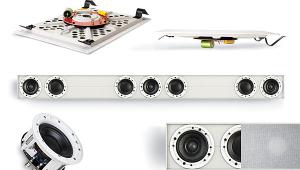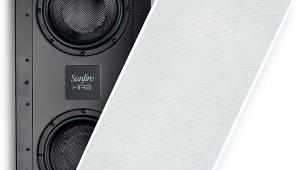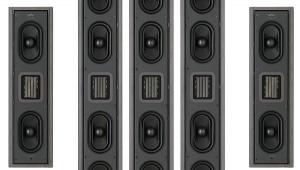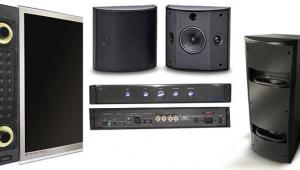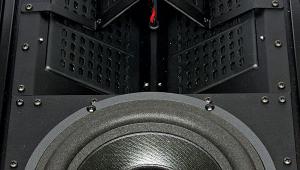It Came From Above Page 4
Once you've drilled holes through all the firebreaks (yes, there may be more than one) and the header board, you'll have to fish the wire down through the collective holes. This is best achieved using a fiberglass fish tape with the wire taped to it (see step-by-step photos). An excellent source for this and any other special installation tools you could possibly need is the installer's best friend: Labor Saving Devices.
 The accompanying photos illustrate the steps taken to install this system. It should be noted that, while the techniques documented here may be applicable to your project, there are many variables this installation doesn't cover. Unless you are extremely confident in your abilities, I'd recommend contracting a qualified installer in your area. In fact, I'd advise checking with a number of installers to determine their prices (usually hourly), as well as their policies concerning installing speakers they don't sell. You might want to begin by contacting the Custom Electronic Design & Installation Association (CEDIA) to find member companies that service your area. To provide a point of reference, this installation took AVE three hours, for a total cost of $255 (plus wire).
The accompanying photos illustrate the steps taken to install this system. It should be noted that, while the techniques documented here may be applicable to your project, there are many variables this installation doesn't cover. Unless you are extremely confident in your abilities, I'd recommend contracting a qualified installer in your area. In fact, I'd advise checking with a number of installers to determine their prices (usually hourly), as well as their policies concerning installing speakers they don't sell. You might want to begin by contacting the Custom Electronic Design & Installation Association (CEDIA) to find member companies that service your area. To provide a point of reference, this installation took AVE three hours, for a total cost of $255 (plus wire).
The Ends Justify the Means
Once the system was complete and the installer was off to his next gig, it was time to enjoy the fruits of his labor. The installation was finished by mid-Saturday morning, so I devoted the remainder of the weekend to putting the system through a serious testing cycle. I found that changing the direction of the swiveling speaker and tweeter did affect the overall audio presentation. After some trial and error, I had the speakers aimed where they sounded best for the prime seating areas. I loaded my CD changer with as varying an array of music as I could find—everything from hard-core rock-'n'-roll to symphony recordings to Delta blues to piano-only work. I hit the CD player's random button and kicked back for a weekend of eclectic listening.
 What immediately struck me was the authority with which these speakers presented audio, yet even more impressive was how well they reproduced the quieter and subtler passages in symphony and piano work. In my travels through audio testing, I've found that a speaker's ability to handle sophisticated low-level passages is where many of them fail to live up to their marketing hype. I had no real-time analyzer to graph the speakers; however, through all my listening, there was no area where I felt they lagged. I would describe the speakers as bright, but not so much as to say they have a high-end bias. Like any system that relies on a 61/2-inch driver, the AIM Ones could use a little subwoofer help. For general music listening, though, they perform quite well. I was able to push the AIM Ones to the point of audible distortion, but the SPL level at this point was so high that I couldn't envision a circumstance I'd encounter where such volume would be needed. The point being, the speakers supply ample headroom for reasonable listening levels.
What immediately struck me was the authority with which these speakers presented audio, yet even more impressive was how well they reproduced the quieter and subtler passages in symphony and piano work. In my travels through audio testing, I've found that a speaker's ability to handle sophisticated low-level passages is where many of them fail to live up to their marketing hype. I had no real-time analyzer to graph the speakers; however, through all my listening, there was no area where I felt they lagged. I would describe the speakers as bright, but not so much as to say they have a high-end bias. Like any system that relies on a 61/2-inch driver, the AIM Ones could use a little subwoofer help. For general music listening, though, they perform quite well. I was able to push the AIM Ones to the point of audible distortion, but the SPL level at this point was so high that I couldn't envision a circumstance I'd encounter where such volume would be needed. The point being, the speakers supply ample headroom for reasonable listening levels.
I have employed these speakers every single day since they were installed. At $400 a pair, the AIM Ones present not only excellent sound but a great value, as well. With a total cost of $1,089 for the gear and $255 for installation, this system represents a wonderful and affordable way to introduce yourself and your family unit to the joys of multiroom audio—be it Frank Sinatra's version of "My Way," the Sid Vicious rendition, or both.
- Log in or register to post comments



